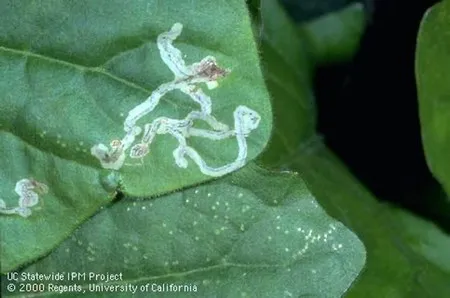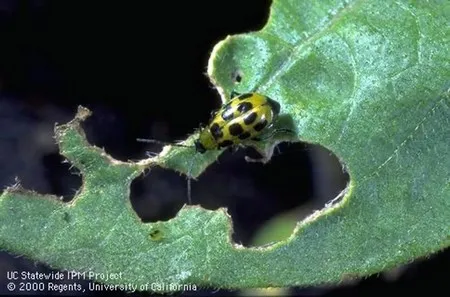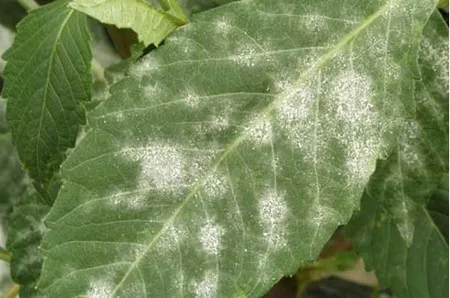Late-Summer Dahlia Problems - What's up?
A favorite summer flower is dahlias – little ones, big ones and even really big ones as is Dahlia imperialis growing from 8 to 12 feet tall.
Were your dahlias looking fantastic earlier this summer, full of stunning blooms and healthy leaves but now they are starting to look a little tired? Here is a short list of some pests and diseases to watch out for in late summer.
Leafminers. White squiggles on, or more appropriately, in the leaves are an indication of leafminers. Adult leafminers are small black flies which lay their eggs inside the leaves. You may be able to see tiny dots where the eggs were deposited. When the eggs hatch, the larvae feed on the interior of the leaves. The white squiggles are the tunnels or “mines” created by their feeding. Since the larvae are inside the leaves, insecticides are not effective. The damage is cosmetic and rarely kills plants.

Spotted cucumber beetle. Those “green ladybugs” are not ladybugs! They are spotted cucumber beetles. If you are seeing holes in the leaves and petals, they are a likely culprit. While chewed leaves and petals are unsightly, the larger issue is that the beetle can transmit plant viruses. A simple control for spotted cucumber beetles is to hand pick them and drop them into a cup of soapy water. The best time to do this is in the morning when the beetles are still sleepy and moving slowly. Be sure to look deeply into the flowers – they tend to nestle between the petals.

Powdery mildew. Starting in the late summer and into the fall, powdery mildew moves in. You may have noticed a white powdery substance on leaf surfaces. Along with affecting dahlias, you may see it on other garden plants including sunflowers, zucchini, lilacs and crepe myrtle. While powdery mildew generally won’t kill a plant, it can be detrimental to the plant’s health and growth.
The best approach for powdery mildew is prevention – there are no dahlia cultivars completely resistant to powdery mildew. Providing regular irrigation, and planting in full sun (except in the hottest part of the county) will go far in supporting vigorous, healthy plants. Removing the bottom two sets of lower leaves can improve air circulation which will also help. Perhaps surprisingly, overhead watering can help reduce powdery mildew by rinsing it off. This should be done in the middle of the day to allow the leaves to dry quickly. Fungicides are another option. Least toxic choices include horticultural oils such as neem. As always, when using any type of pesticide, including fungicides, be sure to follow the label.

Viruses: Dahlias are subject to a number of viruses, including cucumber mosaic virus, and dahlia mosaic virus. Mottled, spotted and yellowing (chlorotic) leaves, discolored flowers and stunted growth can indicate the presence of a virus. Unfortunately, there is no cure and no resistant variety. Prevention is the only approach. Start with clean stock. Be sure to sterilize your tools between cuts, including when dividing the tubers. Control aphids and cucumber beetles, and especially thrips to reduce transmission. An infected plant should be completely discarded. It will not magically return as a healthy plant next year.
With a little backup from us, especially as the season winds down, your dahlias can shine well into the fall. A quick daily check-in with your plants can catch problems early. Remove anything that looks suspicious, encourage airflow, and make sure the plants receive regular water.
Your dahlias can still shine well into fall if you stay on top of things. Happy growing—and may your blooms stay beautiful!
Resources
UC IPM Pest Notes
Leafminers: https://ipm.ucanr.edu/home-and-landscape/vegetable-leafminers/#gsc.tab=0
Cucumber beetles: https://ipm.ucanr.edu/PMG/GARDEN/VEGES/PESTS/cucumberbeet.html
Powdery mildew: https://ipm.ucanr.edu/home-and-landscape/powdery-mildew-on-ornamentals/pest-notes/#gsc.tab=0
Viruses: https://ipm.ucanr.edu/PMG/GARDEN/PLANTS/DISEASES/viruses.html
Thrips: https://ipm.ucanr.edu/PMG/PESTNOTES/pn7429.html
UC IPM
Growing dahlias: https://ipm.ucanr.edu/PMG/GARDEN/FLOWERS/dahlia.html
Washington State University
Dahlia Resource Center: https://dahlia.wsu.edu/dahlia-resource-center/
Dahlia Mosaic: https://hortsense.cahnrs.wsu.edu/fact-sheet/dahlia-virus/
Other
American Dahlia Society: https://www.dahlia.org/
Help Desk of the UC Master Gardeners of Contra Costa County (DAK)
